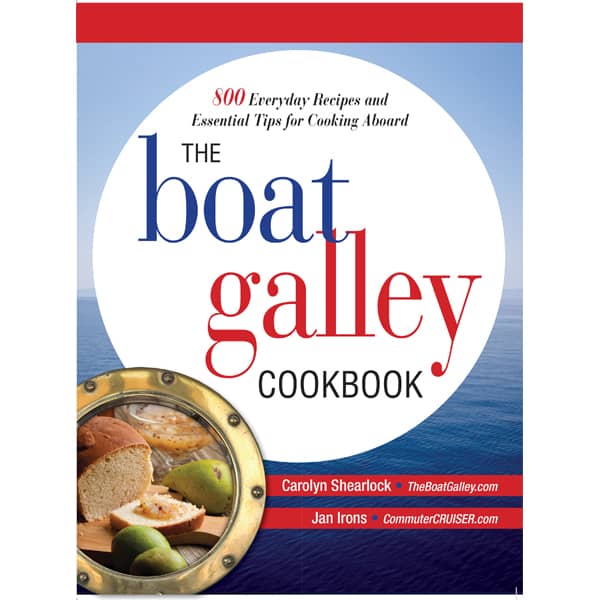Thermos cooking is perfect in the boat galley! It saves propane, keeps heat out of the boat, and you get to do something else while the food cooks. Additionally, Thermos cooking makes using some foods that save space and weight aboard a boat – such as dried beans instead of canned – feasible.
UPDATE: For larger quantities, and for cooking main dishes, take a look at a thermal cooker (I love mine!).
Before You Start Thermos Cooking
The basic technique is simple: heat the ingredients, put them in a Thermos, generally let it sit for 4 to 8 hours, then eat. As with everything, the devil is in the details. Over the years, I’ve learned 11 key points for successful Thermos cooking.
Plan Ahead
Thermos cooking takes time. So you can’t decide to cook dinner in a Thermos an hour before you want to eat.
Select the Right Thermos
You need one that is
- Well-insulated. The more heat it retains, the better it will cook.
- Sized right. Your food needs to fill the Thermos in order to cook most efficiently.
- Wide mouth. This makes it much easier to get food in and out, and also to clean.
I particularly like the Thermos Nissan “vacuum bottles” (that’s the generic name for a Thermos). They are made of stainless steel and get the highest marks for holding heat in numerous reviews. The 48-ounce Thermos Nissan wide-mouth bottle (1-1/2 quarts) (Amazon) is good for soups, stews, chili, spaghetti sauce and things like that. The 16-ounce (2 cup) size (Amazon) is good for a single food for two people. Another good brand is Zojirushi (Amazon).
Read more about the best Thermos Bottles.
Beware of inexpensive plastic “insulated bottles” – while they may keep coffee warm for an hour, they simply don’t hold heat well enough to use for Thermos cooking. They also stain and pick up odors from the foods in them.
Cook Appropriate Foods
It must be something that is cooked in liquid. Thermos cooking is best for single foods or dishes where everything needs to cook the same length of time, or to pre-cook part of a dish, such as:
- rice (particularly non-instant brown rice, which has the most nutrients but otherwise has to simmer 45 minutes),
- soups, stews and chili (see my recipe for Split Pea Soup in a Thermos)
- spaghetti sauce,
- soaking and cooking dried beans for use in a recipe (see recipe),
- cooking beef or chicken for use in a soup, casserole or Mexican dish,
- reconstituting dried and freeze-dried foods, and
- most recipes designed for crock pots, if you adjust quantities to fit your Thermos.
Don’t even try to cook the following in a Thermos:
- foods that are easily overcooked
- dishes that require many additions of extra ingredients, which causes heat to escape each time
- dishes with cheese in them (unless it’s added at the end of the cooking time) – it sticks to the inside of the Thermos and is very hard to get out
- foods that cannot be brought to a full boil before putting it into the bottle. Yogurt is one exception to this — see how to make your own yogurt.
Thermos Cooking Techniques
Now that you have right tools and a plan to start thermos cooking, here’s how to do it.
Preheat Bottle
Before preparing the food to be cooked, boil water, fill the Thermos, and stopper it. Let it sit at least 5 minutes to thoroughly heat the inside of the bottle. Otherwise, a lot of the heat in the food will be used up in heating the bottle, and not in further cooking the food. Don’t empty the water until you’re ready to fill the Thermos with food. Save the water to use in something else.
Fill the Thermos in the Sink
Whenever you’re pouring hot water or a hot mixture into the Thermos, put the Thermos in the sink first. This way, anything that spills or splashes will be contained in the sink. Since the sink is lower than the counter, it’s easier to pour things this way and you’re also less likely to spill things since it’s a more convenient height. It also helps to use a canning funnel (Amazon) when you’re pouring hot food into the Thermos.
Brown Meat
Just as with cooking in a crock pot, anything that must be browned – such as meat and onions for chili – should be browned before being mixed with the other ingredients. Meat and other ingredients will cook in the Thermos, but it won’t brown.
Pre-Cook Food
This was the biggest mistake I made on my first attempt. I just put all the non-liquid ingredients in the bottle and then poured boiling water over the top. Six hours later, my split pea soup was still a mass of raw ingredients and lukewarm water. The heat from the boiling water just moderately warmed up the other ingredients and there was not enough heat to complete the cooking.
Pre-cooking doesn’t just mean putting things into a pan and heating them to boiling, then pouring it into the Thermos. The cooking has to actually begin before you put the food into the bottle. Cook things right up to where you’d turn the heat down and let them simmer.
Cooking Times
Cooking times will vary, depending on how well the Thermos retains heat, the temperature where the Thermos sits, and how large the food pieces are in the Thermos (smaller pieces cook faster). The table below provides approximate cooking times for single items.
| Item | Pre-Cook Time (after food comes to a boil) | Thermos Time |
| White Rice (not instant)* | 5 minutes | 1-1/2 hours |
| Brown Rice (not instant)* | 5 minutes | 4 to 5 hours |
| Beef stew meat – 1” cubes | 15 minutes | 4 hours |
| Chicken – 1” pieces | 8 minutes | 3 hours |
| Beans, dried – to soak | 5 minutes | 2 hours |
| Beans, dried – after soaking (change water) | 10 minutes | 3 hours |
| Potato – 1” cubes | 5 minutes | 2 hours |
*Because rice expands beyond the volume of water it soaks up, leave an extra 1” of room at the top
For soups, stews, chili, spaghetti sauce and other things like that, cook them as usual on the stove up to the point where the recipe says to “simmer for x hours.” Instead, put the food in the pre-heated Thermos and let it sit for approximately twice as long.
Re-Heat if Necessary
Depending on the temperature around the bottle (40 degrees in the boat versus 100), the quality of the bottle, and the total time needed to cook, you may need to reheat the contents so that they will continue cooking.
Until you’ve learned how well your bottle keeps heat in your climate, you should check the contents halfway through the allotted time if the total Thermos time is over 3 hours. If steam does not rise up when you open the contents, you need to reheat the contents.
To reheat, pour the Thermos contents into a pan and re-stopper the bottle to keep the heat in (unless you’re in a very cold climate, you don’t need to re-preheat the bottle). Bring the food to a full rolling boil, then put it back in the Thermos and re-stopper it.
Finishing on the Stove
There is nothing wrong with serving food right from the Thermos. However, for foods that aren’t going to be incorporated into another dish, I prefer to cook them traditionally for 5 to 10 minutes after taking them from the Thermos. This gives me the chance to add more water or boil some away if needed and add any extra spices that a taste reveals are needed. But if you’re trying to conserve propane or want something to take along on a hike, it certainly isn’t necessary!
Cleaning Your Thermos
A bottle brush (Amazon) is a big help for cleaning your bottle. Just use regular dish soap, and baking soda will help remove any food odors or stuck bits. Do not use steel wool or “Brillo”-type pads on glass liners (can scratch the glass, leading to breakage) or stainless bottles (can cause rust).
Thermos cooking is a great technique for making cooked meals without heating up your boat. I hope these tips will make it an easy, go-to technique for you.
Related Posts

Carolyn Shearlock has lived aboard full-time for 17 years, splitting her time between a Tayana 37 monohull and a Gemini 105 catamaran. She’s cruised over 14,000 miles, from Pacific Mexico and Central America to Florida and the Bahamas, gaining firsthand experience with the joys and challenges of life on the water.
Through The Boat Galley, Carolyn has helped thousands of people explore, prepare for, and enjoy life afloat. She shares her expertise as an instructor at Cruisers University, in leading boating publications, and through her bestselling book, The Boat Galley Cookbook. She is passionate about helping others embark on their liveaboard journey—making life on the water simpler, safer, and more enjoyable.
Simplify meal prep on board with proven strategies for provisioning, maximizing fridge space, and cooking delicious meals aboard your boat.










The Boat Galley says
Yes it is! Pages 70 to 74 🙂